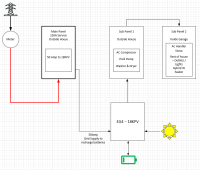Looking for suggestions / recommendation on how to move my house consumption over to an EG4 – 18kPV unit but still maintain a live grid connection for battery recharging ONLY.
I have a 2 panel (typical layout) Main panel outside with a few heavy loads and a Sub panel in my garage. The easiest way would be to wire the grid feed out from the meter into the EG4 BUT I really don’t want to involve the utility company or have to pull permits.
After head scratching the past month the best, I can come up with is to remove the 240v loads from the main panel into a new SUB panel outside and then somehow daisy-chain or combine the 2 sub panels fed from the AC output of the EG4. (is there a specific combiner box / enclosure for performing this type of connection).
All thoughts welcome, thanks.

I have a 2 panel (typical layout) Main panel outside with a few heavy loads and a Sub panel in my garage. The easiest way would be to wire the grid feed out from the meter into the EG4 BUT I really don’t want to involve the utility company or have to pull permits.
After head scratching the past month the best, I can come up with is to remove the 240v loads from the main panel into a new SUB panel outside and then somehow daisy-chain or combine the 2 sub panels fed from the AC output of the EG4. (is there a specific combiner box / enclosure for performing this type of connection).
All thoughts welcome, thanks.








